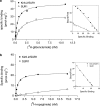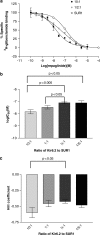Kir6.2-dependent high-affinity repaglinide binding to beta-cell K(ATP) channels
- PMID: 15678092
- PMCID: PMC1576033
- DOI: 10.1038/sj.bjp.0706082
Kir6.2-dependent high-affinity repaglinide binding to beta-cell K(ATP) channels
Abstract
1. The beta-cell K(ATP) channel is composed of two types of subunit - the inward rectifier K(+) channel (Kir6.2) which forms the channel pore, and the sulphonylurea receptor (SUR1), which serves as a regulatory subunit. The N-terminus of Kir6.2 is involved in transduction of sulphonylurea binding into channel closure, and deletion of the N-terminus (Kir6.2DeltaN14) results in functional uncoupling of the two subunits. In this study, we investigate the interaction of the hypoglycaemic agents repaglinide and glibenclamide with SUR1 and the effect of Kir6.2 on this interaction. We further explore how the binding properties of repaglinide and glibenclamide are affected by functional uncoupling of SUR1 and Kir6.2 in Kir6.2DeltaN14/SUR1 channels. All binding experiments are performed on membranes in ATP-free buffer at 37 degrees C. 2. Repaglinide was found to bind with low affinity (K(D)=59+/-16 nM) to SUR1 alone, but with high affinity (increased approximately 150-fold) when SUR1 was co-expressed with Kir6.2 (K(D)=0.42+/-0.03 nM). Glibenclamide, tolbutamide and nateglinide all bound with marginally lower affinity to SUR1 than to Kir6.2/SUR1. 3. Repaglinide bound with low affinity (K(D)=51+/-23 nM) to SUR1 co-expressed with Kir6.2DeltaN14. In contrast, the affinity for glibenclamide, tolbutamide and nateglinide was only mildly changed as compared to wild-type channels. 4. In whole-cell patch-clamp experiments inhibition of Kir6.2DeltaN14/SUR1 currents by both repaglinide and nateglinde is abolished. 5. The results suggest that Kir6.2 causes a conformational change in SUR1 required for high-affinity repaglinide binding, or that the high-affinity repaglinide-binding site includes contributions from both SUR1 and Kir6.2. Glibenclamide, tolbutamide and nateglinide binding appear to involve only SUR1.
Figures




References
-
- AGUILAR-BRYAN L., NICHOLS C.G., WECHSLER S.W., CLEMENT J.P., BOYD A.E., GONZLEZ G., HERRERA-SOSA H., NGUY K., BRYAN J., NELSON D.A. Cloning of the beta cell high-affinity sulfonylurea receptor: a regulator of insulin secretion. Science. 1995;268:423–426. - PubMed
-
- AMBAVANE V., PATIL R., AINAPURE S.S. Repaglinide: a short acting insulin secretagogue for postprandial hyperglycaemia. J. Postgraduate Med. 2002;48:246–248. - PubMed
-
- ASHCROFT F.M. Ion Channels: exciting times for PIP2. Science. 1998;282:1059–1060. - PubMed
-
- ASHCROFT F.M., GRIBBLE F.M. Correlating structure and function in ATP-sensitive K+ channels. Trends Neurosci. 1998;21:288–294. - PubMed
-
- ASHCROFT F.M., RORSMAN P. ATP-sensitive K+ channels: a link between B-cell metabolism and insulin secretion. Biochem. Soc. trans. 1990;18:109–111. - PubMed
Publication types
MeSH terms
Substances
LinkOut - more resources
Full Text Sources
Medical
Molecular Biology Databases

